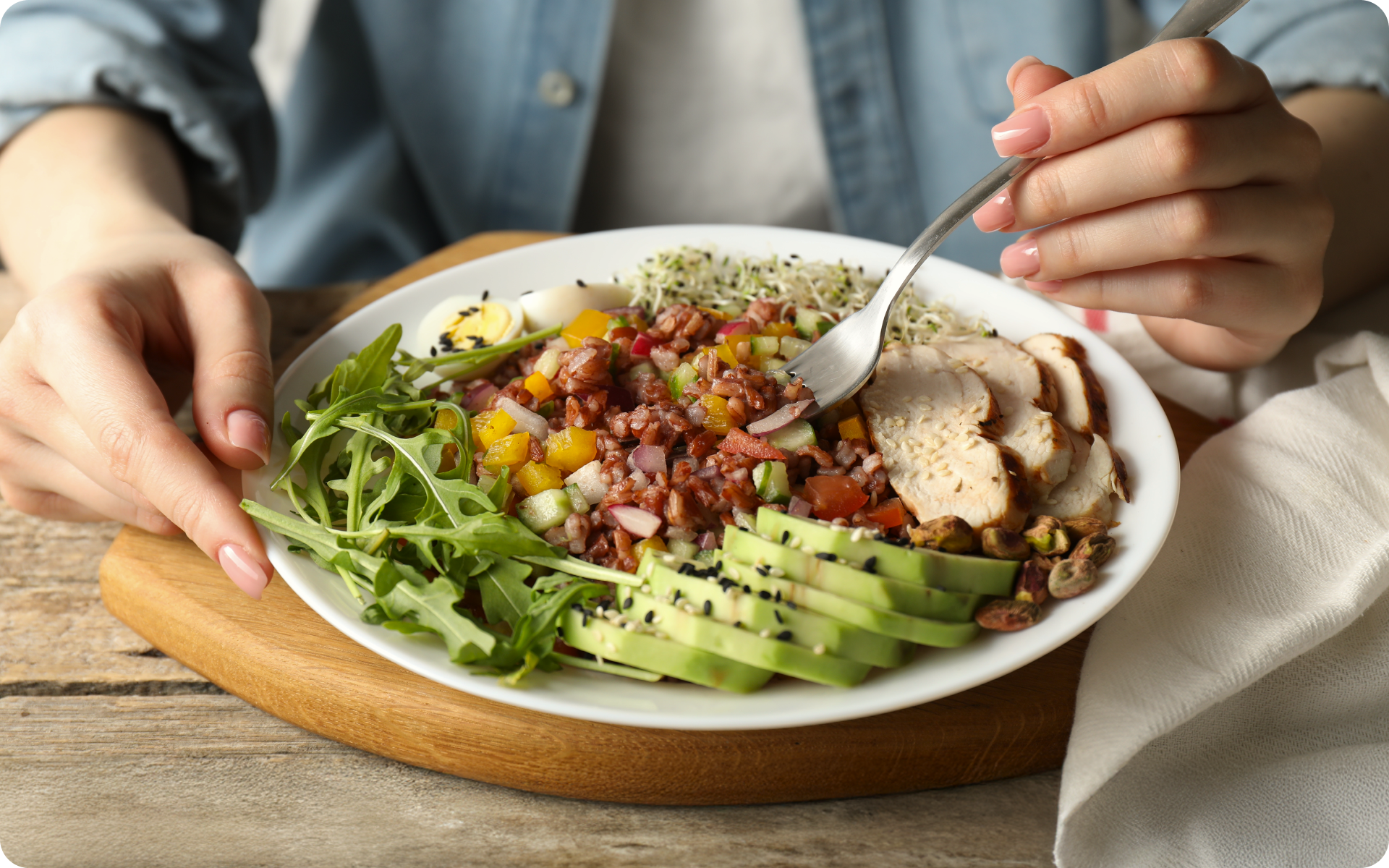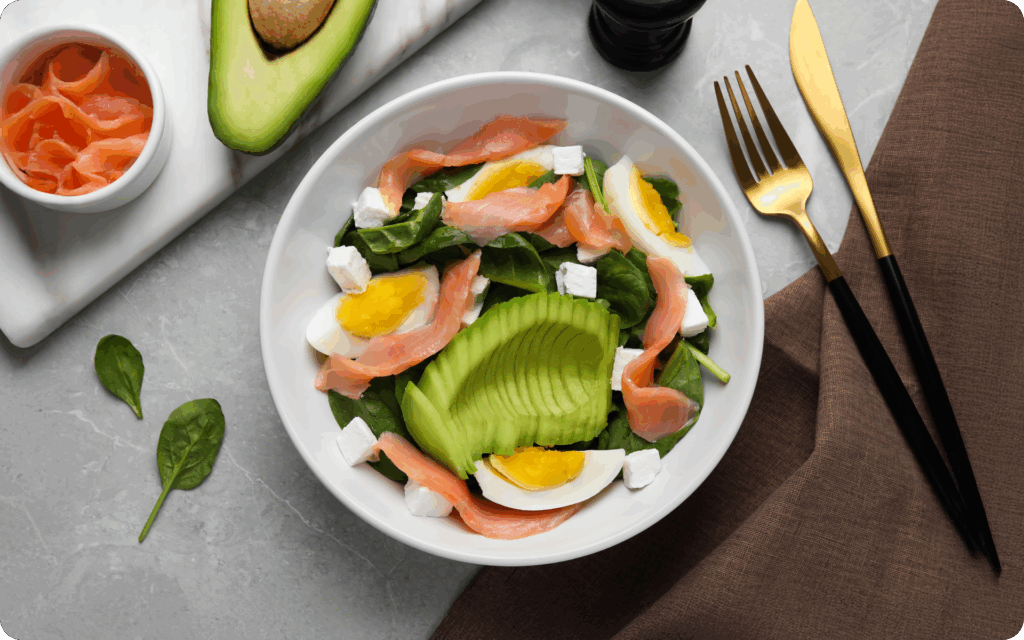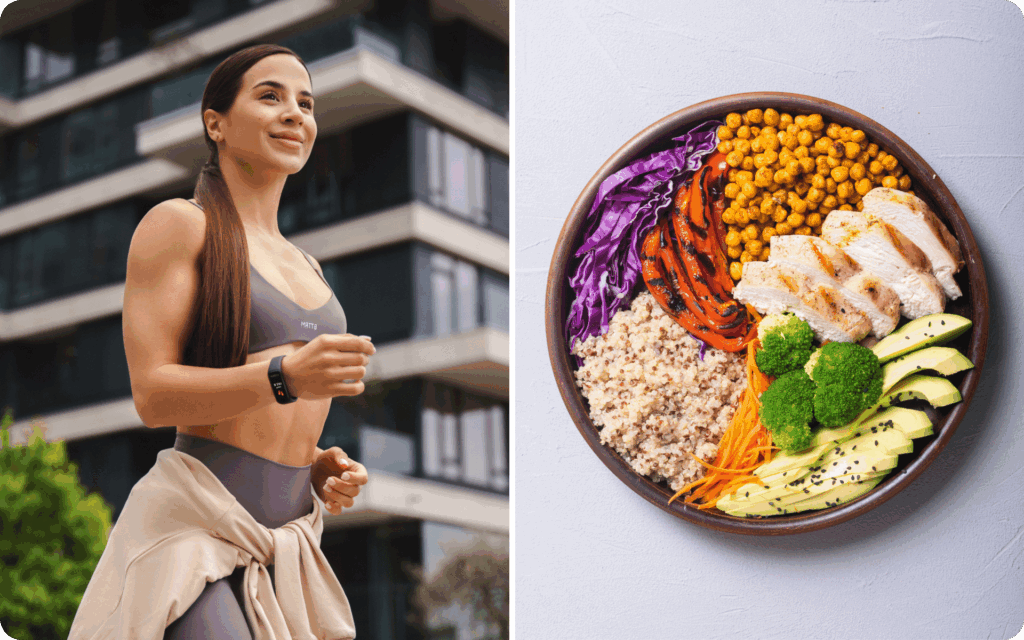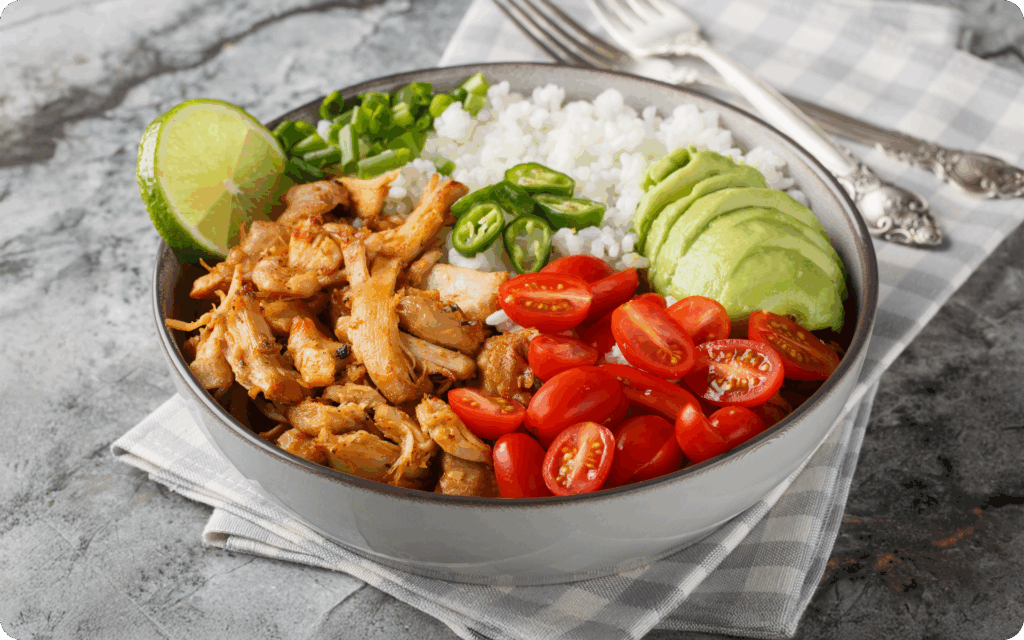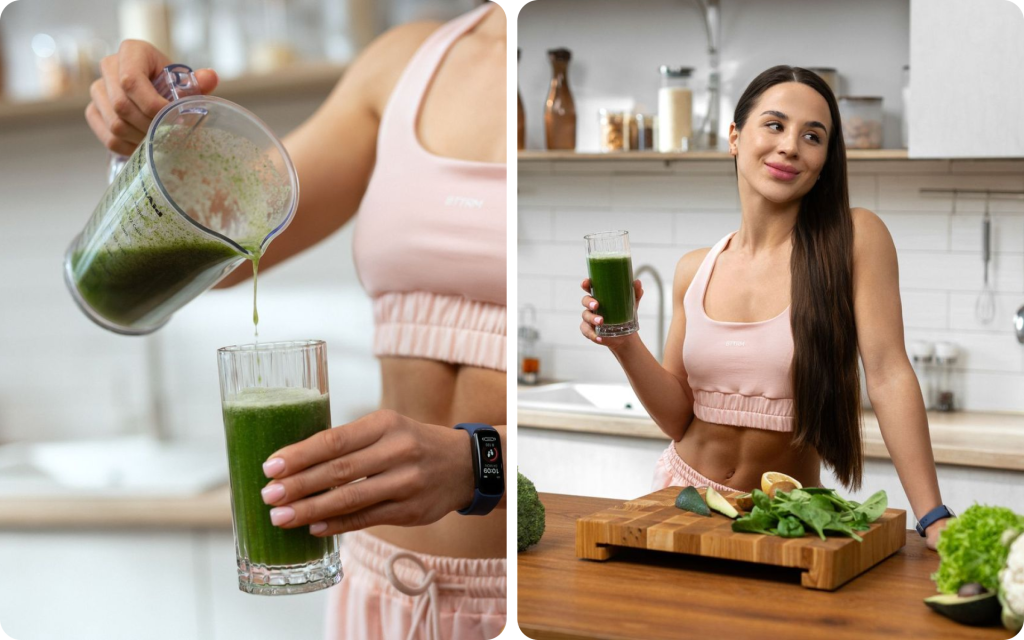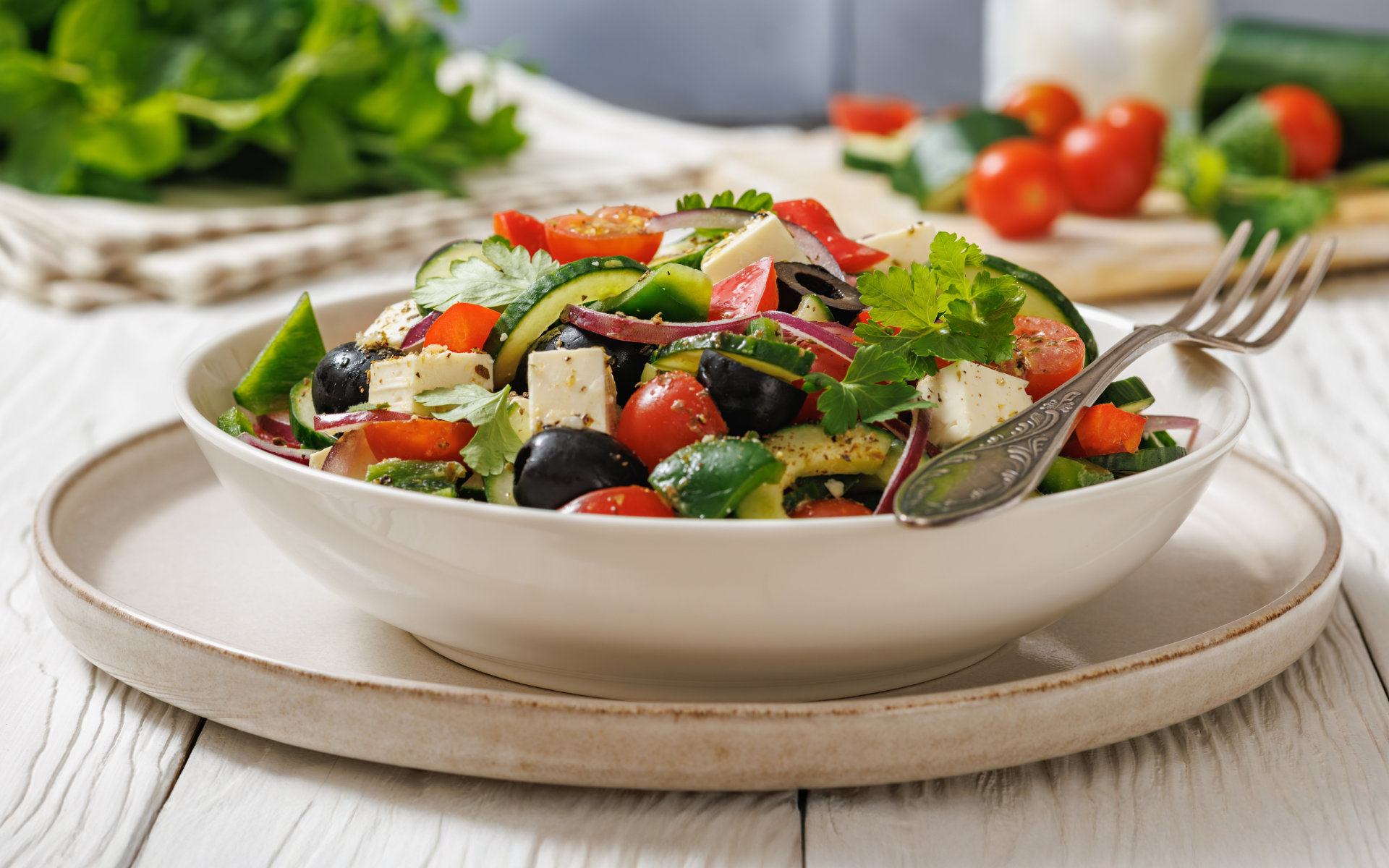Belly fat isn’t something you can target by doing crunches or drinking “magic” belly fat-burning teas. Fat loss is influenced by many factors, including your diet, activity levels, genetics, and even stress. There’s also so much misinformation and unhelpful tips out there that it can be overwhelming to know where to start.
While no single strategy works for everyone, one promising approach is a high-protein diet. In two weeks of eating more protein, you’re likely to feel fuller and snack less. Depending on what else you eat, you may even start to lose a few pounds. But what exactly is a high-protein diet and how does it help with fat loss?
Here’s what you need to know, and a sample menu to get you started.
What Burns the Most Belly Fat?
When it comes to burning belly fat, the answer lies in one simple truth: a calorie deficit. A calorie deficit happens when you consume fewer calories than your body burns. It’s the core principle behind all fat loss, no matter the method (1).
While the concept is simple, the paths to creating and sustaining a calorie deficit vary widely in approach, effectiveness, and long-term impact on health.
How Fat Loss Happens
Before we get into the methods, here’s a quick look at the science. Like other fat in your body, belly fat is stored energy. When your body needs energy and you’re in a calorie deficit, it taps into those energy stores, breaking fat down into smaller components that can be used for fuel (2).
This process happens systemically, which means you can’t pick and choose where your body burns fat from first. For many people, belly fat may be more stubborn to lose due to genetics and hormonal factors.
The Paths to a Calorie Deficit
Now, how do you create that calorie deficit? There are countless methods, but they generally fall into two categories:
Healthy and Sustainable Approaches
Healthy strategies prioritize your overall well-being and aim for gradual, consistent results. Here are some examples:
These approaches work without drastic changes that may harm your metabolism or overall health. For example, combining calorie control with exercise creates a gentle but effective calorie deficit over time.
- Nutrient-dense eating: Focus on foods that are high in nutrients but lower in calories, such as vegetables, fruits, lean proteins, and whole grains (3).
- High-protein diets: Increasing protein can help you feel full longer, preserve muscle mass, and increase the “thermic effect of food”, which is the energy your body uses to digest and process nutrients (4).
- Increasing physical activity: Exercise, particularly a mix of strength training and cardiovascular activity, helps burn calories and supports muscle maintenance (5).
- Managing stress and sleep: High levels of the stress hormone cortisol and poor sleep quality can impact fat storage, particularly around the midsection (6, 7). Addressing these factors is often overlooked but very important.
When it comes to weight loss, progress is made by inches, not miles, so it’s much harder to track and a lot easier to give up. The BetterMe: Health Coaching app is your personal trainer, nutritionist, and support system all in one. Start using our app to stay on track and hold yourself accountable!
Unsustainable and Risky Methods
These are often tempting as they promise rapid results, but they come at a cost to your health and long-term success. Examples include:
- Extreme calorie restriction: Eating far too few calories can lead to rapid weight loss but is unsustainable, causes nutrient deficiencies, and often results in muscle loss.
- Fad diets: Programs that overemphasize one food group or promote “detoxes” often lack scientific backing and fail to support long-term healthy habits.
- Over-exercising: Exercising excessively without proper rest leads to burnout and increased injury risk and may actually raise cortisol, which makes fat loss harder.
These methods can harm your body and set you up for rebound weight gain, which makes them less effective in the long run. If you’re curious about the high protein 1800-calorie meal plan, check out our earlier article.
A Sustainable Approach Is Best
Sustainable methods may take more patience, but they’re far more rewarding. They help preserve muscle mass, support long-term metabolic health, and are easier to maintain as part of your daily routine.
Belly fat, particularly visceral fat, is sensitive to consistent, modest changes in nutrition and activity. Focus on what you can stick to over months or years, not just two weeks or a month.
Read more: 7 Benefits of Not Snacking and What Happens to Your Body When You Quit
Can You Lose Fat by Just Eating Protein?
Protein plays a crucial role in any fat loss plan, but relying solely on it isn’t the answer. While it’s true that protein has unique benefits that support fat loss, the idea of losing fat by “just eating protein” oversimplifies the bigger picture of nutrition and metabolism.
Protein’s Role in Fat Loss
Protein is often called the “building block” of the body, and for good reason. It helps repair and maintain tissues, including muscles. When it comes to fat loss, protein has some standout qualities:
- Satiety: Protein helps you feel full longer, which can naturally lead to eating less. This is because it takes longer to digest, which influences hunger hormones such as ghrelin, helping you manage your appetite (8).
- Muscle preservation: During weight loss, your body can lose not just fat but also muscle. Protein supports muscle retention (9), which is important because more muscle helps you burn more calories, even at rest (10). Doing strength training exercises is the other key part of the puzzle for preserving muscle.
- Thermic effect: Digesting protein burns more calories compared to carbohydrates or fats. This is called the thermic effect of food (TEF), and it gives protein a slight metabolic advantage (11)
These benefits make protein a key player in fat loss. But does that mean that eating only protein will help you lose fat? Not quite.
Why Protein Alone Isn’t Enough
Your body needs more than protein to function properly. Carbohydrates and fats are also essential for health and energy. Here’s why:
- Carbohydrates provide energy for daily activities and workouts (12). Cutting carbs too low can leave you feeling tired or make it harder to exercise at your best. To learn more about the high-protein low-carb diet meal plan, check out our in-depth article on the topic.
- Fats aren’t just a source of energy. They play a role in hormone production, brain health, and absorption of fat-soluble vitamins (such as A, D, E, and K) (13).
Simply eating all the protein in the world won’t fuel your workouts, balance your hormones, or provide nutrients your body needs to thrive.
Without a balance of macronutrients (protein, carbohydrates, and fats), your body may struggle to keep up with the demands of daily life, even as it works to burn fat.
The Importance of Balance
A sustainable fat loss diet should include all three macronutrients. Here’s how balance supports your goals:
- Protein helps maintain muscle and keeps you full.
- Carbs fuel your brain and muscles, particularly during physical activity.
- Fats support overall health and help regulate hormones that influence fat metabolism.
When these macronutrients work together, the result is more sustainable fat loss and better energy levels, digestion, and long-term health.
What Is the Best Protein for Losing Belly Fat?
Balancing a variety of protein sources ensures you get all essential nutrients while keeping your meals enjoyable and adaptable:
- Animal-Based Proteins
Animal-based proteins, such as chicken, fish, eggs, and dairy products, are often considered some of the most complete protein sources. This means they contain all nine essential amino acids your body can’t produce on its own (14).
Amino acids are important for muscle repair, immune function, and many other bodily processes (15). Foods such as chicken breast or lean cuts of beef are particularly popular for fat loss as they’re high in protein but relatively low in fat, which makes them calorie-efficient.
Fish, such as salmon or mackerel, is another standout. While these are higher in fat, they also contain omega-3 fatty acids. Omega-3s are healthy fats thought to support heart health and reduce inflammation, which may indirectly support better fat metabolism (16).
Eggs are also a versatile option, offering high-quality protein and a range of nutrients, particularly in the yolk (17).
While animal proteins can fit well into a weight loss plan, portion control is key, as higher-fat options such as certain cuts of beef, cheese, or full-fat yogurt can quickly increase calorie intake. For more details about the low-calorie high-protein meal plan , take a look at our prior publication.
- Plant-Based Proteins
For those on plant-based diets or who are simply looking to include more variety, plant proteins are a strong contender (14). Options such as beans, lentils, tofu, and quinoa offer substantial protein, together with fiber, which supports digestion and adds to satiety.
Fiber’s role is particularly valuable in weight loss, as it helps you feel fuller for longer, which reduces the likelihood of overeating (18).
However, one challenge with plant-based proteins is that they’re often incomplete, missing one or more essential amino acids (14). For example, beans may lack methionine, an essential amino acid, and whole grains such as rice are low in lysine. The solution? Pairing complementary proteins, or simply including a variety of different plant-based proteins in your overall diet (19).
A classic example is rice and beans, which together provide all essential amino acids. Including a mix of plant-based protein sources throughout your day ensures you’re covering your nutrient needs while keeping your meals satisfying and nutrient-dense.
The BetterMe: Health Coaching app will provide you with a host of fat-frying fitness routines that’ll scare the extra pounds away and turn your body into a masterpiece! Get your life moving in the right direction with BetterMe!
- Protein Supplements
Protein supplements, such as whey, casein, or plant-based powders made from peas, soy, or rice, can be a convenient way to meet your protein needs.
- Whey protein, for example, is absorbed quickly and often used post-exercise to help with muscle recovery (20).
- Casein, on the other hand, digests slowly and can be helpful for maintaining satiety over extended periods, such as overnight (21).
- Plant-based options such as pea protein are great for those who are avoiding animal products and are often fortified with additional amino acids to fill any gaps in their profile (22).
Despite their convenience, it’s important to treat supplements as just that – a supplement to, not a replacement for, a balanced diet. Whole foods, which provide vitamins, minerals, fiber, and other beneficial compounds, should still make up the majority of your diet.
Supplements can fill gaps when you’re busy or after a workout but shouldn’t be relied on exclusively. Watch for added sugars or unnecessary fillers in some powders, which can counteract your weight loss goals.
Read more: How to Build a Healthy Dinner Plate, According to Experts
What Is a 2-Week High-Protein Diet Menu for Losing Belly Fat?
A high-protein diet for fat loss typically includes approximately 20-30% of your daily calories from protein, which is near the high end of the recommended range of 10-35% (23). Another way to determine your protein goal is to take your weight in kilograms and multiply it by 1.2 to 1.6, which will give you a protein target in grams. Anything above the recommended 0.8 grams of protein per kilogram of body weight is considered high protein, but 1.2 to 1.6 g/kg is a common target range.
The other macronutrients, carbohydrates and fats, shouldn’t be ignored. Carbs should make up 45-65% of total calories, providing energy to fuel your day and workouts, while fats could account for the remaining 20-35%, supporting hormones and overall health (23). This balance helps keep your meals satisfying and sustainable over time.
With this in mind, here are some practical, high-protein meal ideas for two weeks. These are simple, satisfying ideas you can mix and match based on your preferences:
Breakfast Ideas
- Eggs and Vegetables: Scramble two to three eggs with spinach, bell peppers, and a sprinkle of cheese. Pair with a slice of whole-grain toast or a serving of fruit.
- Greek Yogurt Bowl: Use plain, unsweetened Greek yogurt as the base, then add a handful of berries, a drizzle of honey, and a sprinkle of chopped nuts.
- Protein Oats: Stir a scoop of protein powder into warm oatmeal and top with banana slices and a tablespoon of peanut butter.
Lunch Suggestions
- Grilled Chicken Salad: Toss grilled chicken breast with mixed greens, cherry tomatoes, cucumbers, and a light olive oil and lemon dressing. Add a boiled egg for extra protein and some brown rice or another whole grain for energy.
- Turkey and Avocado Wrap: Use a whole-grain tortilla, layer it with turkey slices, avocado, lettuce, and tomato, and roll it up for an easy, portable lunch.
- Tuna and Quinoa Bowl: Mix canned tuna (in water, drained) with cooked quinoa, steamed broccoli, and a spoonful of Greek yogurt for creaminess. Season with lemon and black pepper.
Dinner Options
- Baked Salmon with Vegetables: Roast a salmon filet in the oven with olive oil, lemon, and herbs. Serve with a side of roasted asparagus and sweet potato.
- Turkey Stir-Fry: Sauté lean ground turkey with mixed vegetables such as carrots, snap peas, and bell peppers. Add low-sodium soy sauce and serve over a small scoop of brown rice.
- Lean Beef and Vegetable Skewers: Thread cubes of lean beef, zucchini, mushrooms, and bell peppers onto skewers. Grill or bake until cooked through, and enjoy with a side salad and whole-grain or whole-wheat pasta.
Snack Suggestions
- Cottage Cheese and Fruit: Cottage cheese is high in protein and pairs well with sliced pineapple, peaches, or a few grapes.
- Hard-Boiled Eggs: Prep a batch of hard-boiled eggs in advance for a grab-and-go option. Pair with baby carrots or celery sticks for an extra crunch.
- Protein Smoothie: Blend a scoop of protein powder with almond milk, frozen berries, and a handful of spinach for a quick, nutrient-packed snack.
What Happens if You Eat a High-Protein Diet Without Exercise?
Eating a high-protein diet without incorporating exercise can still influence changes in your body, although the outcomes may vary.
Protein is essential for muscle repair and maintenance, but without the stimulus of exercise, particularly strength training, your muscles don’t receive signals to grow or strengthen. Here’s what typically happens:
- Minimal muscle development: While eating more protein ensures your body has the building blocks (amino acids) for muscle repair, exercise is necessary to create the demand that stimulates muscle growth (24).
- Satiety benefits remain: Protein is highly satiating, which means that it can reduce hunger and help you feel full longer. Even without exercise, this may naturally lead to eating fewer calories, potentially supporting your weight loss goals.
- Risk of muscle loss during weight loss: If your goal is fat loss and you’re in a calorie deficit, the lack of exercise may cause your body to break down muscle tissue for energy alongside fat. This means you could lose strength and reduce your metabolic rate over time, as muscle burns more calories at rest than fat does.
Furthermore, exercise has a ton of health benefits, beyond weight loss. When you exercise, you improve cardiorespiratory endurance, muscle strength and function, bone density, flexibility, and balance. Regular exercise also reduces your risk of chronic diseases such as heart disease, diabetes, obesity-related cancers, and depression.
What Happens if You Only Eat Protein and No Carbs?
Protein performs specific roles in the body, but it can’t replace the energy or nutrient diversity carbs provide. Not eating any carbs may lead to:
- Energy Deficits
Carbohydrates are the body’s preferred source of energy, particularly for the brain and muscles. Without them, you may feel fatigued, experience brain fog, or struggle with high-intensity activities (25).
- Ketosis Risk
If you drastically reduce carbs but keep protein intake high, your body may enter a state called ketosis. This happens when the body uses fat as its primary energy source. While ketosis isn’t inherently harmful for most healthy people, it can cause symptoms such as bad breath, fatigue, or nausea early on (often called the “keto flu”) (26).
- Lack of Essential Nutrients
Many carb-rich foods, such as whole grains, fruits, and vegetables, provide fiber, vitamins, and minerals that support digestion and overall health. Omitting them may increase the risk of nutrient deficiencies or issues such as constipation.
What Are the Symptoms of Too Much Protein?
While protein is essential, consuming it in excess can have negative consequences. Here are some symptoms and potential issues that may arise:
- Digestive discomfort: A high protein intake, particularly from animal sources, can lead to constipation or bloating, particularly if your fiber intake is low. Fiber helps your digestive system run smoothly, and most high-protein foods lack it (27).
- Kidney strain: For healthy individuals, eating a high-protein diet is unlikely to harm the kidneys. However, for those with pre-existing kidney conditions or risks, excess protein may place extra strain on these organs, as they work to filter waste products like urea produced during protein metabolism (28).
- Dehydration risk: Breaking down protein produces nitrogen, which increases the amount of urine your body excretes (29). Without enough hydration, this can lead to dehydration symptoms such as headaches, fatigue, or dark urine.
- Weight gain potential: Excess protein is still calories, and consistently eating more than your body needs can result in weight gain. Surplus calories, whether from protein, carbs, or fat, are stored as body fat.
To avoid these issues, focus on consuming protein in moderation. Most people need 0.8-1.6 grams of protein per kilogram of body weight, depending on their activity levels and goals. Balance your protein intake with adequate carbs, fats, and hydration for optimal health.
The appropriateness of consuming 200g of protein depends on your individual needs, body weight, and activity level. For most people, daily protein requirements range from 0.8 to 1.6 grams of protein per kilogram of body weight, with some less common circumstances requiring more (30). For a highly active individual or someone who engages in strength training, 200g may be reasonable if their body weight and caloric needs warrant it, but this is rare. However, for those with lower energy requirements, 200g may exceed their nutritional needs and could lead to excess calorie intake, digestive discomfort, or stress on the kidneys over time. It’s always best to calculate your protein needs using your weight, activity level, and health goals. Rice can be part of a weight loss plan when it’s eaten in moderation and balanced with protein, healthy fats, and vegetables. It provides energy through carbohydrates, which are essential for fueling your body. Opting for whole-grain varieties such as brown or wild rice offers added fiber, which supports digestion and increases feelings of fullness (31). Portion control is key, as rice is calorie-dense and can contribute to overeating if consumed in large amounts. Combining it with lean proteins, healthy fats, and vegetables helps create a balanced, satisfying meal. Yes, eggs are an excellent choice for weight loss due to their high protein content and nutrient density. One large egg contains approximately 6 grams of protein and essential vitamins such as B12 and choline, while being relatively low in calories (31). Protein helps keep you full longer, potentially reducing overall calorie intake. In addition, eggs are versatile and easy to prepare, which makes them a convenient option for meals or snacks. Simply pair them with fiber-rich foods, such as vegetables or whole grains, to create a balanced meal. Potatoes can be good for weight loss when they’re prepared healthily and eaten in moderation. They are rich in complex carbohydrates, fiber, potassium, and vitamins such as C and B6. Boiled or baked potatoes, for example, can be filling without being calorie-heavy (32), which makes them a great addition to meals. However, fried or heavily processed potato dishes, such as French fries or chips, are high in fats and calories, which can hinder weight loss. Pairing potatoes with protein and vegetables enhances their nutritional value and creates a balanced, satisfying plate.Frequently Asked Questions
Is 200g of protein too much?
Is rice good for weight loss?
Are eggs good for weight loss?
Are potatoes good for weight loss?
The Bottom Line
A 2-week high-protein diet menu can be an effective and practical approach to support fat loss, particularly when paired with balanced macronutrients and portion control. High-protein meals help keep you full, preserve lean muscle, and stabilize energy levels.
However, it’s essential to combine this diet with regular exercise and include a variety of foods to meet all your nutritional needs. Sustainable fat loss comes from creating a healthy, enjoyable routine, not extreme, restrictive eating habits.
DISCLAIMER:
This article is intended for general informational purposes only and does not serve to address individual circumstances. It is not a substitute for professional advice or help and should not be relied on for making any kind of decision-making. Any action taken as a direct or indirect result of the information in this article is entirely at your own risk and is your sole responsibility.
BetterMe, its content staff, and its medical advisors accept no responsibility for inaccuracies, errors, misstatements, inconsistencies, or omissions and specifically disclaim any liability, loss or risk, personal, professional or otherwise, which may be incurred as a consequence, directly or indirectly, of the use and/or application of any content.
You should always seek the advice of your physician or other qualified health provider with any questions you may have regarding a medical condition or your specific situation. Never disregard professional medical advice or delay seeking it because of BetterMe content. If you suspect or think you may have a medical emergency, call your doctor.
SOURCES:
- What is the Required Energy Deficit per unit Weight Loss? (2008, pmc.ncbi.nlm.nih.gov)
- Physiological process of fat loss (2019, bnrc.springeropen.com)
- Optimal Diet Strategies for Weight Loss and Weight Loss Maintenance (2020, pmc.ncbi.nlm.nih.gov)
- Higher compared with lower dietary protein during an energy deficit combined with intense exercise promotes greater lean mass gain and fat mass loss: a randomized trial (2016, sciencedirect.com)
- Physical Activity and Weight Loss Maintenance (2023, ncbi.nlm.nih.gov)
- Stress and abdominal fat: preliminary evidence of moderation by the cortisol awakening response in Hispanic peripubertal girls (2011, pubmed.ncbi.nlm.nih.gov)
- Sleep Deprivation: Effects on Weight Loss and Weight Loss Maintenance (2022, mdpi,com)
- Dietary protein – its role in satiety, energetics, weight loss and health (2012, cambridge.org)
- Enhanced protein intake on maintaining muscle mass, strength, and physical function in adults with overweight/obesity: A systematic review and meta-analysis (2024, pubmed.ncbi.nlm.nih.gov)
- Increasing muscle mass to improve metabolism (2013, pmc.ncbi.nlm.nih.gov)
- The Effects of High Protein Diets on Thermogenesis, Satiety and Weight Loss: A Critical Review (2013, tandfonline.com)
- High-Quality Carbohydrates and Physical Performance (2018, journals.lww.com)
- Editorial: The role of dietary fatty acids in metabolic health (2023, frontiersin.org)
- Animal- and Plant-Based Protein Sources: A Scoping Review of Human Health Outcomes and Environmental Impact (2022, mdpi.com)
- Amino acids (2023, medlineplus.gov)
- Omega-3 Fatty Acids (2022, my.clevelandclinic.org)
- The Health Benefits of Egg Protein (2022, mdpi.com)
- Unravelling the Effects of Soluble Dietary Fibre Supplementation on Energy Intake and Perceived Satiety in Healthy Adults: Evidence from Systematic Review and Meta-Analysis of Randomised-Controlled Trials (2019, mdpi.com)
- Combining Plant Proteins to Achieve Amino Acid Profiles Adapted to Various Nutritional Objectives—An Exploratory Analysis Using Linear Programming (2022, frontiersin.org)
- Investigating the Health Implications of Whey Protein Consumption: A Narrative Review of Risks, Adverse Effects, and Associated Health Issues (2024, mdpi.com)
- Pre-sleep casein protein ingestion: new paradigm in post-exercise recovery nutrition (2020, pmc.ncbi.nlm.nih.gov)
- The Current Situation of Pea Protein and Its Application in the Food Industry (2022, mdpi.com)
- A high-protein diet for reducing body fat: mechanisms and possible caveats (2014, nutritionandmetabolism.biomedcentral.com)
- Resistance Training Load Effects on Muscle Hypertrophy and Strength Gain: Systematic Review and Network Meta-analysis (2021, journals.lww.com)
- Carbohydrates in the Diet (2021, extension.okstate.edu)
- Consumer Reports of “Keto Flu” Associated With the Ketogenic Diet (2022, frontiersin.org)
- Effects of High-Fiber Diets and Macronutrient Substitution on Bloating: Findings From the OmniHeart Trial (2020, pmc.ncbi.nlm.nih.gov)
- The Effects of High-Protein Diets on Kidney Health and Longevity (2020, pmc.ncbi.nlm.nih.gov)
- Controversies Surrounding High-Protein Diet Intake: Satiating Effect and Kidney and Bone Health (2015, pmc.ncbi.nlm.nih.gov)
- Protein for Life: Review of Optimal Protein Intake, Sustainable Dietary Sources and the Effect on Appetite in Ageing Adults (2018, mdpi.com)
- Rice: Importance for Global Nutrition (2019, pubmed.ncbi.nlm.nih.gov)
- National Egg Day: An Egg-cellent Source of Nutrition (2022, nifa.usda.gov)
